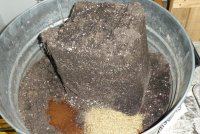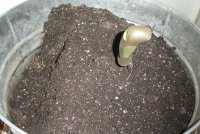Emeraldo
Well-Known Member
...One example is the use of legumes as a cover crop. Farmers will plant legumes to restore SOM (soil organic matter) and improve the N (nitrogen) that are present and collected on the legumes roots. Most of the N is absorbed from the plants leaves from the air and stored in root nodules. When the legumes die back or are harvested, those roots give N back to the soil in the decomposition process.
...
Alfalfa is another such example of crops that actually produce N and restore SOM, and there are many. I have no reason to doubt that everything you said there is true. I guess the same might be true of cannabis root. You can leave the root in your soil and it will decompose and give back whatever it contains. It certainly does no harm.
I guess the only way to really know, as fact, if cannabis root is just bursting with nutrition is to have it tested. There isn't much I could find on the web to corroborate what, if any, nutritional value cannabis root in fact has.
Your analogy to legumes etc is nice -- yes, some plants' roots give N back -- but it doesn't establish as fact what was asserted by nunyabiz, namely, that cannabis root is just full of nutrients. I don't think it is honest to expect others to accept this kind of assertion without questioning the source. That's all I wanted to say.



 You point to a good technique of using compost and peat moss together, and you've cited an article that describes the benefits of doing that. That's all great and believable. It doesn't go to the issue of our new topic. And I don't agree that you know everything about peat moss.
You point to a good technique of using compost and peat moss together, and you've cited an article that describes the benefits of doing that. That's all great and believable. It doesn't go to the issue of our new topic. And I don't agree that you know everything about peat moss.  Ha-ha
Ha-ha , I would say in response to yours, that I did not ask a question about when to flush, or, for that matter, about how flushing could remove nutrients from roots. I never asked either of those questions. Just to be clear.
, I would say in response to yours, that I did not ask a question about when to flush, or, for that matter, about how flushing could remove nutrients from roots. I never asked either of those questions. Just to be clear.



 Roots accumulate phosphorus in large concentration together with trace minerals while leaves and stems are mostly built of nitrogen, so by removing either one of these you change what comes back to soil. I do no-till in air-pots, so I let roots decompose and I don’t see any problems for 6-7 runs. Then limits start to show up which means yield starts going down although you hit the mark with quality... very tasty buds
Roots accumulate phosphorus in large concentration together with trace minerals while leaves and stems are mostly built of nitrogen, so by removing either one of these you change what comes back to soil. I do no-till in air-pots, so I let roots decompose and I don’t see any problems for 6-7 runs. Then limits start to show up which means yield starts going down although you hit the mark with quality... very tasty buds 